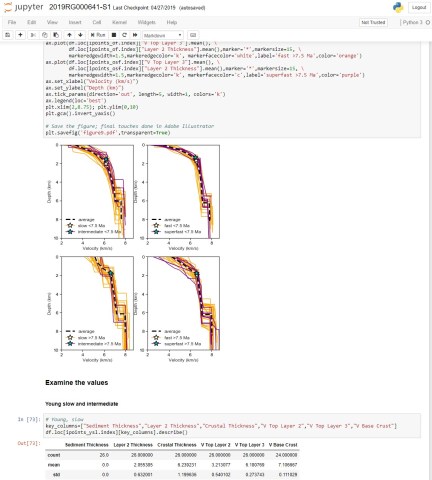New oceanic crust is continuously being formed as magma upwells at mid-ocean ridges. The characteristics of oceanic crust hold clues about its age and the environment in which it formed. A recent article in Reviews of Geophysics synthesized data on oceanic crust from many different studies globally, comparing age and spreading rate. Here, one of the authors gives an overview of what we know about oceanic crust and suggests where additional research is needed.
What are the main characteristics of oceanic crust?
The first marine investigations in the mid-twentieth century discovered that oceanic crust had a distinct layered structure with “pillow lavas” at the top, “sheeted dikes” in the middle, and “gabbros” at the bottom overlying mantle rocks.

How is it possible to study oceanic crust?
Some oceanic crust is easy to study because it is now exposed on land; this is known as an “ophiolite”. This crust was formed many millions of years ago and has subsequently been moved by tectonic forces and eventually ended up above sea level where researchers can examine it in detail.
On the other hand, a vast amount of oceanic crust remains underwater. At fracture zones it is possible to see exposures of oceanic crust, otherwise, we can find out what’s below by drilling into the crust and extracting cores. However, to date, there have only been a few isolated drill holes, and these have only penetrated part way into the oceanic crust.
Thus, much of our knowledge about the structure and composition of oceanic crust and the processes of its formation comes from ophiolites.
How else can we learn about the characteristics of oceanic crust?
Seismic techniques are another way to ‘look’ into the rock below. Seismic waves are sent down into the crust and a signal bounces back. This is used to calculate the “seismic velocity”, which offers clues about the physical properties of rock at different depths, such as different layers and their composition.

Since the earliest studies, the challenge for scientists has been to correlate the layers seen in seismic profiles with known physical rock characteristics observed from ophiolites and drilling so that layer boundaries, such as between dikes and gabbros, can be mapped throughout the ocean basins.
How does new crust vary depending on the rate of spreading?
At fast-spreading ridges magma supply is relatively constant and produces a uniform crust, while at slow-spreading ridges magma supply is more ephemeral and produces a heterogeneous crust. However, rather surprisingly, the structure revealed by seismic imaging is very similar for different spreading rates.
The goal of our new study was to tease out differences related to age and spreading rate by synthesizing data from many studies throughout different ocean basins. We found that the seismic boundary between upper and lower crust is thinner for fast-spreading crust than for slow-spreading crust. The seismic boundary corresponds to the lithologic boundary between dikes and gabbros for fast-spreading crust but marks a change in porosity within the dikes (likely related to faulting) for slow-spreading crust.
What other factors influence the characteristics of the crust?
There is a significant correlation between seismic velocities at the top of the crust and the thickness of the overlying sediment. The thick sediment likely collapses large-scale features such as lava tubes and fractures. Many thick sediment regions are located near continental margins, such as the East Coast of the United States.
Age is also a key influence. Seismic velocities at the top of the crust increase rapidly for the first approximately 10 million years then continue to evolve to the oldest ages in our study (170 million years). We think these changes are related to hydrothermal circulation in the ocean crust, which is very active near the ridge crest but must continue even into older crust.
Overall, we find that our results group into four categories: young, slow-spreading crust; young, fast-spreading crust; old, slow-spreading crust; and old, fast-spreading crust.

For example, young, slow-spreading crust has the lowest velocities at the top of the lower crust which we think is related to deep faults. In contrast, the average crustal thickness is 6.15 kilometers and is similar for crust formed at different spreading rates.
Your paper includes a Jupyter notebook as Supporting Information. How does this benefit other scientists?

A Jupyter notebook is an open-source web application that allows scientists to share and document analysis and visualizations.
Our notebook is written in Python, which is an open source software that is widely available and runs on multiple platforms. We hope that people can use the notebook to analyze the data set in different ways that will lead to discoveries beyond our initial analysis.
Users should also be able to modify the notebook to compare measurements from their own seismic profiles with the compilation values at a specific range of ages and spreading rates. We expect that Jupyter notebooks will become more common since the Python programming language is rapidly growing in popularity.
What are some of the unresolved questions where additional research, data or modeling is needed?
There are only a few deep scientific drill holes in oceanic crust where rock layers can be directly compared with seismic velocities. It’s always a bit scary when you widely extrapolate results based on only a few data points, so additional deep oceanic crust drill holes are definitely desirable.
—Gail Christeson (email: gail@ig.utexas.edu), University of Texas Institute for Geophysics
Citation:
Christeson, G. (2019), Age and speed matters in the formation of new oceanic crust, Eos, 100, https://doi.org/10.1029/2019EO126855. Published on 27 June 2019.
Text © 2019. The authors. CC BY-NC-ND 3.0
Except where otherwise noted, images are subject to copyright. Any reuse without express permission from the copyright owner is prohibited.

